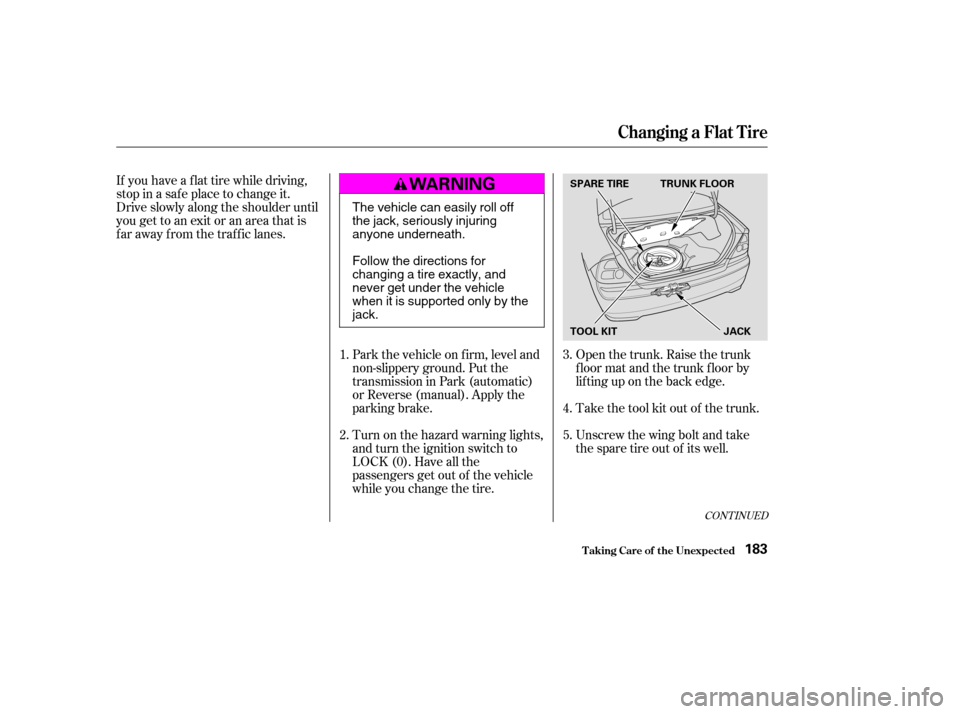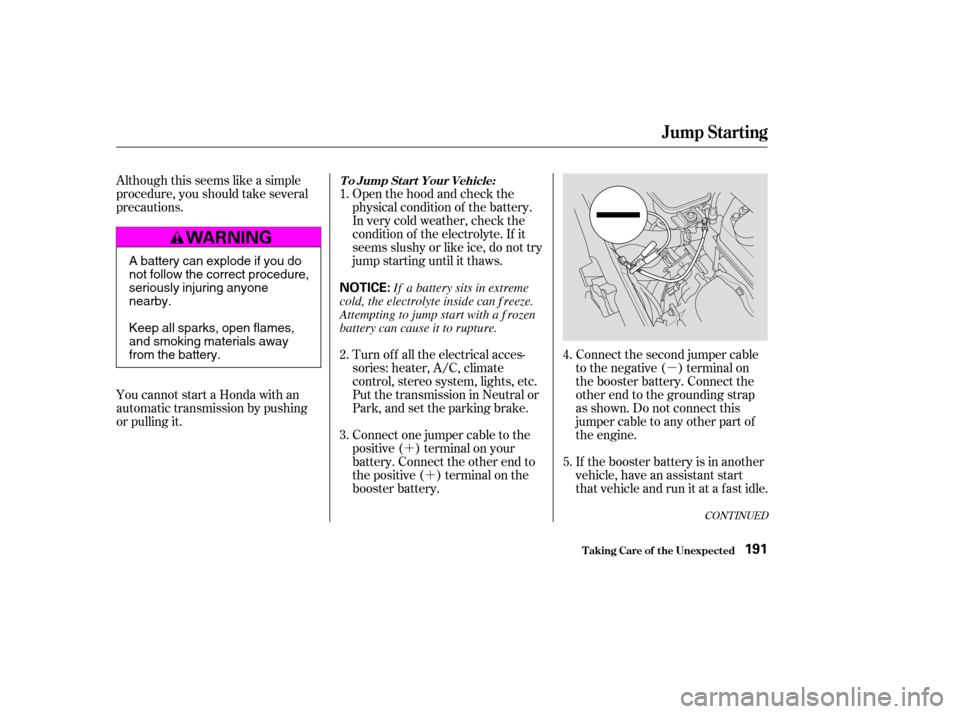Page 182 of 231

Park the vehicle on f irm, level and
non-slippery ground. Put the
transmission in Park (automatic)
or Reverse (manual). Apply the
parking brake.
Turn on the hazard warning lights,
and turn the ignition switch to
LOCK (0). Have all the
passengers get out of the vehicle
while you change the tire.Take the tool kit out of the trunk.
Unscrew the wing bolt and take
the spare tire out of its well.
Open the trunk. Raise the trunk
f loor mat and the trunk f loor by
lif ting up on the back edge.
If you have a f lat tire while driving,
stop in a saf e place to change it.
Drive slowly along the shoulder until
you get to an exit or an area that is
far away from the traffic lanes.
5.
4.
3.
2.
1.
CONT INUED
Changing a Flat T ire
T aking Care of t he Unexpect ed183
SPARE TIRE TRUNK FLOOR
TOOL KIT JACK
The vehicle can easily roll off
the jack, seriously injuring
anyone underneath.
Follow the directions for
changing a tire exactly, and
never get under the vehicle
when it is supported only by thejack.
�����—�����—�����y�
�������������y���
�(���%�������y���
�����y
Page 188 of 231

Diagnosing why your engine won’t
start f alls into two areas, depending
on what you hear when you turn the
key to START (III):You hear nothing, or almost
nothing. The engine’s starter
motor does not operate at all, or
operates very slowly.
You can hear the starter motor
operating normally, or the starter
motor sounds like it is spinning
f aster than normal, but the engine
does not start up and run. Check these things:
When you turn the ignition switch to
START (III), you do not hear the
normal noise of the engine trying to
start. You may hear a clicking sound
or series of clicks, or nothing at all.
Check the transmission interlock.
If you have a manual transmission,
the clutch pedal must be pushed
all the way to the f loor or the
starter will not operate. With an
automatic transmission, it must be
in Park or Neutral.
Turn the ignition switch to ON (II).
Turn on the headlights and check
their brightness. If the headlights
are very dim or don’t light at all,
the battery is discharged. See on page . Turn the ignition switch to START
(III). If the headlights do not dim,
check the condition of the f uses. If
the f uses are OK, there is
probably something wrong with
the electrical circuit f or the
ignition switch or starter motor.
You will need a qualif ied
technician to determine the
problem (see
on page ).
If the headlights dim noticeably or
go out when you try to start the
engine, either the battery is dis-
charged or the connections are
corroded. Check the condition of
the battery and terminal connec-
tions (see page ). You can
then try jump starting the vehicle
f rom a booster battery (see page
).
191 203
178
191
If theEngineWon’tStart
Nothing Happens or the Starter
Motor Operates Very Slowly
Jump Starting Emergency T owing
T aking Care of t he Unexpect ed189
�����—�����—�����y�
�������������y���
�(���%�������y���
�����y
Page 190 of 231

�µ
�´ �´
Although this seems like a simple
procedure, you should take several
precautions.
You cannot start a Honda with an
automatic transmission by pushing
or pulling it.
Connect the second jumper cable
to the negative ( ) terminal on
the booster battery. Connect the
other end to the grounding strap
as shown. Do not connect this
jumper cable to any other part of
the engine.
If the booster battery is in another
vehicle, have an assistant start
that vehicle and run it at a fast idle.
Open the hood and check the
physical condition of the battery.
In very cold weather, check the
condition of the electrolyte. If it
seems slushy or like ice, do not try
jump starting until it thaws.
Turn of f all the electrical acces-
sories: heater, A/C, climate
control, stereo system, lights, etc.
Put the transmission in Neutral or
Park, and set the parking brake.
Connect one jumper cable to the
positive ( ) terminal on your
battery. Connect the other end to
the positive ( ) terminal on the
booster battery.
3.
5.
1. 2.
4.
CONT INUED
Jump Starting
T aking Care of t he Unexpect ed
To Jump Start Your Vehicle:
191
NOTICE:
A battery can explode if you do
not follow the correct procedure,
seriously injuring anyonenearby.
Keep all sparks, open flames,
and smoking materials away
from the battery. If a battery sits in extreme
cold, the electrolyte inside can f reeze.
Attempting to jump start with a f rozen
battery can cause it to rupture.
�����—�����—�����y�����������
���y���
�(���%�������y���
�����y
Page 192 of 231

If you do not see steam or spray,
leave the engine running and
watch the temperature gauge. If
the high heat is due to overloading,
the engine should start to cool
down almost immediately. If it
does, wait until the temperature
gauge comes down to the midpoint,
then continue driving.
If the temperature gauge stays at
the red mark, turn of f the engine.Look f or any obvious coolant leaks,
such as a split radiator hose.
Everything is still extremely hot,
so use caution. If you f ind a leak, it
must be repaired bef ore you
continue driving (see
on page ).
If you don’t f ind an obvious leak,
check the coolant level in the
radiator reserve tank. Add coolant
if the level is below the MIN mark.
Saf ely pull to the side of the road.
Put the transmission in Neutral or
Park, and set the parking brake.
Turn of f all the accessories, and
turn on the hazard indicator.
If you see steam and/or spray
coming f rom under the hood, turn
of f the engine. Wait until you see
no more signs of steam or spray,
then open the hood.
1. 2.
3. 4.5. 6.
203
CONT INUED
If theEngineOverheats
T aking Care of t he Unexpect ed
Emergency
Towing
193
�����—�����—�����y���������������y���
�(���%�������y���
�����y
Page 202 of 231

�µ�µ �µ
There are three popular types of
prof essional towing equipment. The operator
loads your vehicle on the back of a
truck.
The tow
truck uses two pivoting arms that go
under the tires (f ront or rear) and lif t
them of f the ground. The other two
tires remain on the ground. The tow
truck uses metal cables with hooks
on the ends. These hooks go around
parts of the f rame or suspension and
the cables lif t that end of the vehicle
of f the ground. Your vehicle’s sus-
pension and body can be seriously
damaged. Release the parking brake.
Shif t the transmission to Neutral.
Start the engine.
ShifttoD,thentoN.
Turn of f the engine.
If your vehicle needs to be towed,
call a prof essional towing service or
organization. Never tow your vehicle
with just a rope or chain. It is very
dangerous.
If your Honda cannot be transported
by f lat-bed, it should be towed by
wheel-lif t equipment with the f ront
wheels of f the ground. If , due to
damage, your vehicle must be towed
with the f ront wheels on the ground,
do the f ollowing: Release the parking brake.
5-speed Manual Transmission and
Continuously Variable Transmission(CVT)
Automatic Transmission:
CONT INUED
Flat -bed Equipment
Wheel-lif t Equipment Sling-t ype Equipment
This is the best way to trans-
port your Honda.
T his is
an acceptable way to tow your
Honda. T his method of towing
is unacceptable.
Emergency T owing
T aking Care of t he Unexpect ed203
NOTICE: Improper towing preparation
will damage the transmission. Follow
the above procedure exactly. If you
cannot shif t the transmission or start
the engine (automatic transmission),
your vehicle must be transported with
the f ront wheels of f the ground.
�����—�����—�����y�����������
���y���
�(���%�������y���������y
Page 206 of 231
The Engine Number is stamped into
the engine block.
The Transmission Number is on a
label on top of the transmission.
Identif ication Numbers
T echnical Inf ormation207
AUTOMATIC TRANSMISSION NUMBER
ENGINE NUMBER
MANUAL TRANSMISSION
NUMBER
�����—�����—�����y���������������y���
�(���%�������y�����
���y
Page 207 of 231

�Î�Î�Î �Î �Î�Î�Î�Î
�Î �Î
�Î �Î
�Î �Î �Î�Î
�Î
�Î �Î
�´ �´
Specif ications
T echnical Inf ormation208
Dimensions
Weights Capacities
Engine 174.7 in (4,438 mm)
66.7 in (1,695 mm)
55.1 in (1,399 mm)
103.1 in (2,620 mm)
57.9 in (1,470 mm)
57.9 in (1,470 mm)
2.95 x 3.72 in (75.0 x 94.4 mm) 13.2 US gal (50
)
102 cu-in (1,668 cm
)
9.5 9.9
0.108 US gal (0.41
)
4.8 US qt (4.5
)
2.6 US qt (2.5)
6.0 US qt (5.7)
6.3 US qt (6.0)
3.4 US qt (3.2)
2.9 US qt (2.7)
1.7 US qt (1.6)
1.6 US qt (1.5)
4.4 US qt (4.2)
3.5 US qt (3.3)
3.2 US qt (3.0)
3.7 US qt (3.5)
3.4 US qt (3.2)
1.03 US gal (3.9
)
1.00 US gal (3.8)
1.00 US gal (3.8)
1.32 US gal (5.0
)
1.29 US gal (4.9)
1.29 US gal (4.9)
Including the coolant in the reserve tank and that remaining in the
engine.
Reserve tank capacity:
Excluding the oil remaining in the engine.
Length
Width
Height
Wheelbase
Track
Gross vehicle weight rating See the certification label attached
to the driver’s doorjamb.
Water cooled 4-stroke
SOHC , SOHC VTEC
4-cylinder gasoline engine Fuel tank
Engine
coolant
Engine oil Automatic
transmission
fluid
NGK:
DENSO:
Type
BorexStroke
Displacement
Compression ratio
Spark plugs
Spark plug Gap
PZFR6F-11 PKJ20CR-M11
0.04 in (1.1 mm)
FrontRear
Approx.
U.S.: HX, EX
Canada: Si HX
3: 4: 5:6:
7:
1: 2: Change
Manual AutomaticCVT
Total ManualAutomaticCVT
Change
Including
filter
Without filter
Total
ChangeTotal
Change Total
U.S. Vehicles
U.S: HX, EX Canada: Si
U.S: DX, LX
Canada: DX, LX
U.S: DX, LX Canada: DX, LX
1212 5656
7 7
3 4
Manual trans-
mission fluid
Canada Vehicles
Windshield
washer reservoir
0
0.1 mm
�����—�����—�����y���������������y���
�(���%�������y�����
�
�y
Page 214 of 231

If you take your vehicle f or a state
emissions test shortly af ter the
battery has been disconnected or
gone dead, it may not pass the test.
This is because of certain ‘‘readiness
codes’’ that must be set in the on-
board diagnostics f or the emissions
systems. These codes are erased
when the battery is disconnected,
and set again only after several days
of driving under a variety of
conditions.Make sure the gas tank is nearly,
but not completely, f ull (around
3/4).
Make sure the ambient
temperature is between 20° and
95°F.Without touching the accelerator
pedal, start the engine, and let it
idle f or 20 seconds.
Make sure the vehicle has been
parked with the engine of f f or 8
hours or more. Keep the vehicle in Park
(automatic transmission) or
Neutral (manual transmission).
Increase the engine speed to 2,000
rpm and hold it there until the
temperature gauge rises to at least
1/4of thescale(approximately3
minutes).
If the testing f acility determines that
the readiness codes are not set, you
will be requested to return at a later
date to complete the test. If you must
get the vehicle re-tested within the
next two or three days, you can
condition the vehicle for re-testing
by doing the f ollowing.
CONT INUED
St at e Emissions T est ing
T echnical Inf ormation
T esting of Readiness Codes
215
�����—�����—�����y���������������y���
�(���%�������y�����
���y